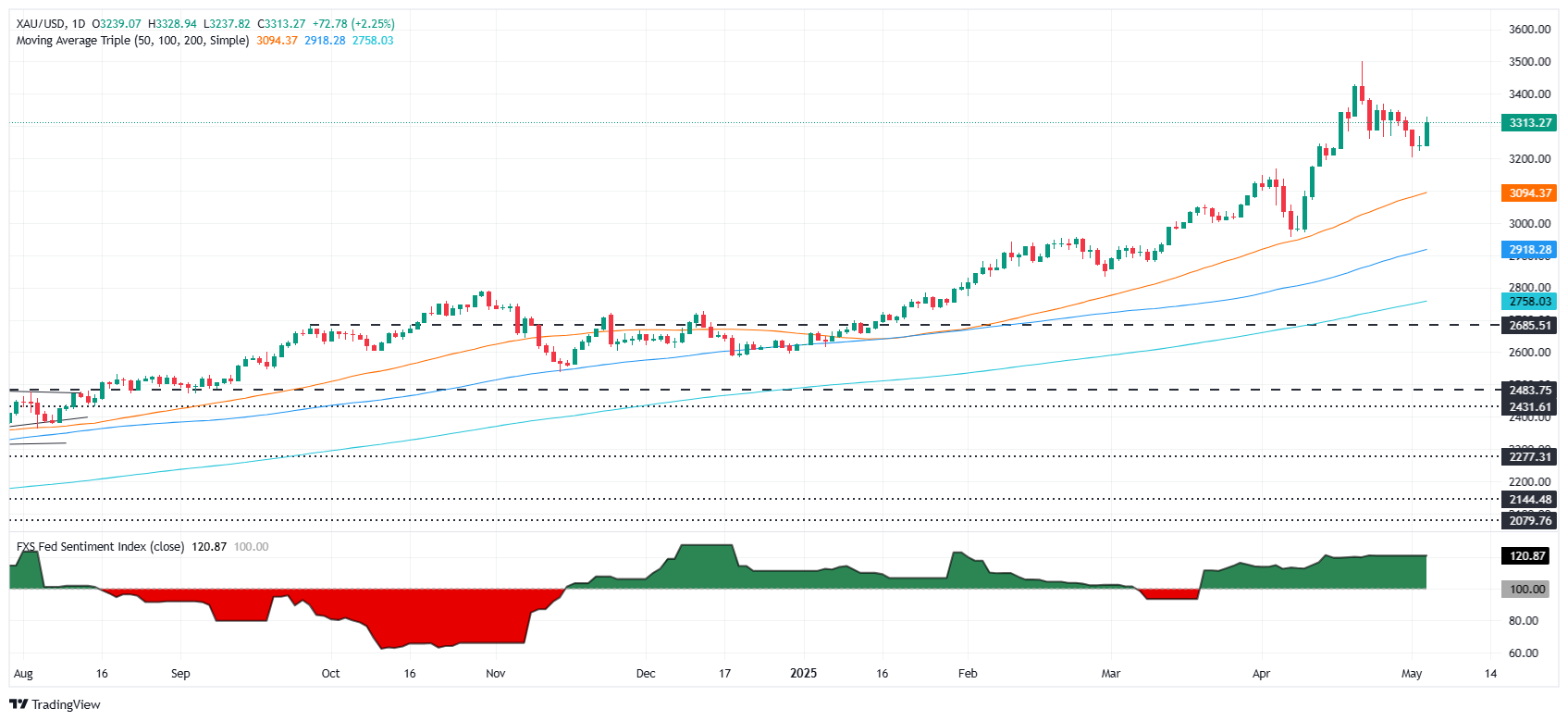Gold price surges above $3,300 as US Dollar sinks, traders eye Fed meeting
- Gold gains 2% as DXY drops, even as ISM Services PMI signals a resilient US economy.
- Trump announces 100% tariffs on foreign films, says Powell won’t be removed early but urges rate cuts.
- Markets fully price in Fed hold on Wednesday; Powell’s press conference in focus for policy signals.
Gold (XAU/USD) prices jumped over 2%, or more than $70, on Monday as the Greenback was battered, although positive economic data from the United States (US) suggests the economy remains solid. XAU/USD trades at $3,309 after bouncing off daily lows of $3,237.
Market mood improved following a report by the Institute for Supply Management (ISM) that service providers reassured the robustness of the US economy. The data hinted that prices are rising, ignited by US President Donald Trump’s tariffs
Over the weekend, Trump announced 100% duties on foreign-produced movies while saying that the Federal Reserve (Fed) should lower interest rates. He said he won’t remove Fed Chair Jerome Powell before his term ends in May 2026.
Trump added that the US is meeting with many countries, including China, and that his main priority is reaching a deal with Beijing.
Meanwhile, traders are bracing for the Federal Reserve monetary policy meeting on Wednesday. The markets have fully priced in that the US central bank will keep rates unchanged, though they will be looking at Fed Chair Jerome Powell's press conference. Policymakers will not update their forecasts until the June meeting, which could provide some hints regarding monetary policy.
Daily digest market movers: Gold price unfazed by higher US Treasury bond yields
- Bullion prices remain underpinned, although US Treasury bond yields rise. The US 10-year Treasury note yield climbs four and a half basis points to 4.35%. At the same time, US real yields rallied five bps to 2.087%, as shown by the US 10-year Treasury Inflation-Protected Securities yields.
- The ISM Services PMI rose to 51.6 in April, up from 50.8 and beating expectations of 50.6, signaling a modest improvement in service sector activity.
- Notably, the Prices Paid sub-index surged to 65.1—its highest since February 2023—up from 60.9, indicating a reacceleration in input inflation pressures.
- Last week’s US Nonfarm Payroll figures for April exceeded estimates despite trailing March’s numbers, suggesting that the labor market remains solid. Worth noting that the Unemployment Rate was unchanged at 4.2%, justifying the Fed’s stance of wait-and-see mode regarding monetary policy.
XAU/USD technical outlook: Gold price poised to challenge $3,350
Gold price uptrend resumed as today’s price action confirmed a ‘bullish harami’ two-candle chart pattern, indicating that bulls are gathering steam. The Relative Strength Index (RSI) further confirmed the latter, as the RSI’s line aims upwards.
Therefore, traders will face key resistance levels like $3,350, followed by the $3,400 figure. If surpassed, the next stop would be $3,450 and $3,500. Conversely, if sellers drag XAU/USD spot price below $3,300, look for a test of the May 1 low of $3,202, ahead of the April 3 high turned support at $3,167.

Gold FAQs
Gold has played a key role in human’s history as it has been widely used as a store of value and medium of exchange. Currently, apart from its shine and usage for jewelry, the precious metal is widely seen as a safe-haven asset, meaning that it is considered a good investment during turbulent times. Gold is also widely seen as a hedge against inflation and against depreciating currencies as it doesn’t rely on any specific issuer or government.
Central banks are the biggest Gold holders. In their aim to support their currencies in turbulent times, central banks tend to diversify their reserves and buy Gold to improve the perceived strength of the economy and the currency. High Gold reserves can be a source of trust for a country’s solvency. Central banks added 1,136 tonnes of Gold worth around $70 billion to their reserves in 2022, according to data from the World Gold Council. This is the highest yearly purchase since records began. Central banks from emerging economies such as China, India and Turkey are quickly increasing their Gold reserves.
Gold has an inverse correlation with the US Dollar and US Treasuries, which are both major reserve and safe-haven assets. When the Dollar depreciates, Gold tends to rise, enabling investors and central banks to diversify their assets in turbulent times. Gold is also inversely correlated with risk assets. A rally in the stock market tends to weaken Gold price, while sell-offs in riskier markets tend to favor the precious metal.
The price can move due to a wide range of factors. Geopolitical instability or fears of a deep recession can quickly make Gold price escalate due to its safe-haven status. As a yield-less asset, Gold tends to rise with lower interest rates, while higher cost of money usually weighs down on the yellow metal. Still, most moves depend on how the US Dollar (USD) behaves as the asset is priced in dollars (XAU/USD). A strong Dollar tends to keep the price of Gold controlled, whereas a weaker Dollar is likely to push Gold prices up.
